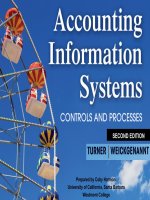Lecture Accounting information systems: Chapter 13 - Richardson, Chang, Smith
Bạn đang xem bản rút gọn của tài liệu. Xem và tải ngay bản đầy đủ của tài liệu tại đây (267.32 KB, 17 trang )
Chapter 13
The Balanced
Scorecard
and
Business Value of
Information
Technology
Copyright © 2014 McGrawHill Education. All rights reserved. No reproduction or distribution without the prior written consent of McGrawHill Education.
Learning Objectives
•
•
•
•
•
LO#1 Describe the balanced scorecard
framework
LO#2 Explain the purpose of strategy maps
LO#3 Describe different types of IT and why IT
initiatives can be difficult to evaluate
LO#4 Define the balanced scorecard
management process
LO#5 Describe how an AIS system contributes
to a balanced scorecard management process
13-2
LO# 1
The Balanced Scorecard
•
•
•
•
A strategic planning and management
system
Used extensively in business and industry,
government, and nonprofit organizations
worldwide
Aligns business activities to the vision and
strategy of the organization,
Improves internal and external
communications
13-3
LO# 1
Four Perspectives
F in a n c ia l
P e rsp e c tive
Lo w e r
Co st s
B u sin e ss P ro c e ss
P e rs p e c tiv e
G ro w
Revenue
En h a n ce
C u st o m e r
V a lu e
C u sto m e r
P e rsp e c tive
Im p ro ve
P r o c e sse s
L e a rn in g &
G ro w th
P e rsp e c tive
13-4
LO# 1
Learning & Growth Perspective
•
•
Describes the firm’s objectives for
improvements in tangible and intangible
infrastructure
Human Capital – investment in people
–
•
Ensuring the right people with the right skills
are available
Information Capital – investment in
information
–
Ensuring required access to information
and
13-5
LO# 1
Process Perspective
1.
2.
3.
Operations management processes,
such as supply, production, distribution,
and risk management.
Customer management processes,
such as those involved with the selection,
acquisition, and retention of customers,
and growth of the firm’s market.
Innovation processes, such as
identifying opportunities, research and
13-6
development, product design and
LO# 1
Customer Perspective
•
The value proposition differentiates from
the competition
–
Product attributes
•
Price
•
Quality
•
Availability
•
Function
–
Service attributes
–
Brand image
13-7
LO# 1
Financial Perspective
•
•
•
Confirms the success of the firm’s
investments and its ability to deliver value
to customers
Overall objective is shareholder value
(for-profit companies)
Other objectives usually related to:
–
Long-term growth
–
Productivity
13-8
LO# 1
Why a Balanced Scorecard
Leading
Indicators
Internal
Perspectives
Lagging
Indicators
External
Perspectives
13-9
LO# 2
Strategy Maps
•
•
•
A one-page representation of the firm’s
strategic priorities
Shows the cause-and-effect linkages
among strategic priorities
Allows organizations to assess and
prioritize gaps between current and
desired performance levels
13-10
LO# 2
Financial
Perspective
Productivity
Strategies
Growth
Strategies
Shareholder
Value
Product Attributes
Relationship
Customer
Perspective
Customer
Value
Service Attributes
Internal
Process
Perspective
Learning &
Growth
Perspective
Operations
Management
Human Capital
Image
Customer
Management
Information Capital
Innovation
Regulatory & Social
Organization Capital
13-11
LO# 3
Roles of AIS/IT in Balanced
Scorecard Framework
•
•
Balanced scorecard recognizes the
difference between
–
Investments in tangible information
technology, and
–
The capabilities created by that technology
Information Capital in the Learning &
Growth Perspective is an intangible asset
that reflects the readiness of the
organization’s technology to support
13-12
business processes
LO# 3
Nature of Information
Technology Investments
•
Function IT
–
•
Network IT
–
•
Performs a single function, such as enhancing
worker productivity for standalone tasks
Allows people to communicate with one
another
Enterprise IT
–
Restructures interactions within the
organization as well as with external
partners
13-13
LO# 3
Summary of 3 IT Investment
Categories
IT
Categor
y
Description
Characteristics
Function Assists execution
IT
with discrete tasks
Does not require complements
but impact can increase with the
users skill
Network Facilitates
Does not require complements
IT
interactions
but impact increases with users’
skill and extent of teamwork
Enterpris Specifies the nature Requires complements and
e IT
of business
impact often depends on users’
processes and
skills, teamwork, changes to the
requires
way work is performed, and
interactions
changes in the way decisions
are made
13-14
LO# 5
The Balanced Scorecard
Management Process
•
The steps necessary to plan, implement,
and monitor performance:
1.
Formulate. The company examines its
competitive environment and identifies ways
in which it can best compete consistent with
its mission, vision, and values.
2.
Translate. The company establishes specific
objectives, measures, targets and initiatives,
and develops capital, initiative, and other
long-term budgets to guide resource
allocation and action according to 13-15
its strategy.
LO# 4
13-16
LO# 5
•
Role of AIS/IT in Balanced
Scorecard Management
IT has an important
role in implementing
Process
and managing the balanced scorecard
management process
•
•
•
Provides information to support strategy
formulation
Provides processing to develop and
distribute budgets for strategy execution
Collects data and converts to information
to assess performance against strategic
13-17









